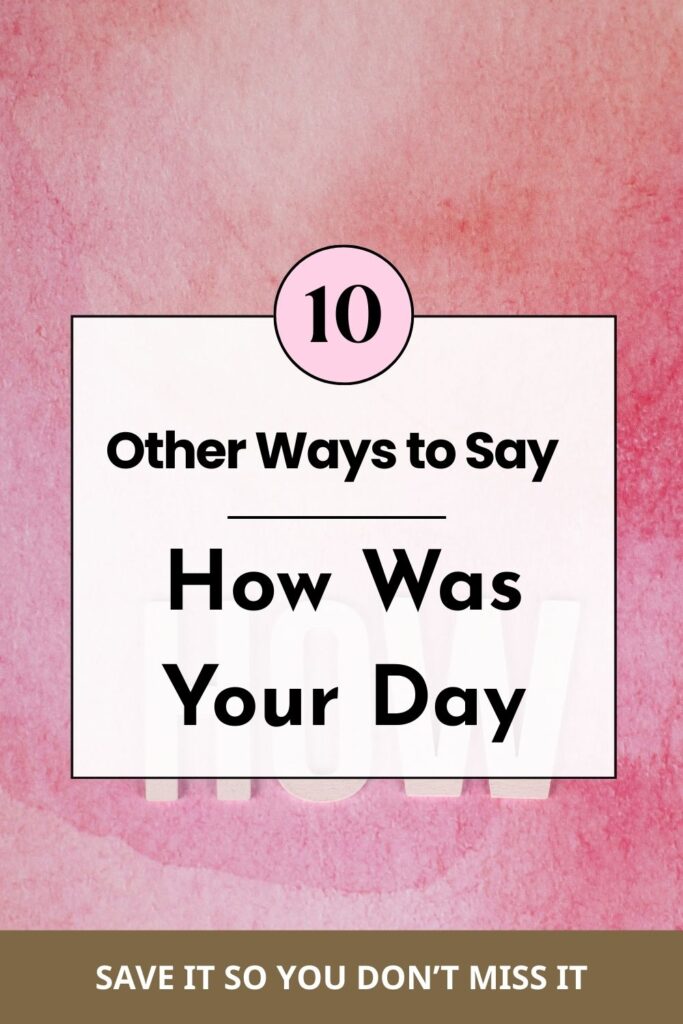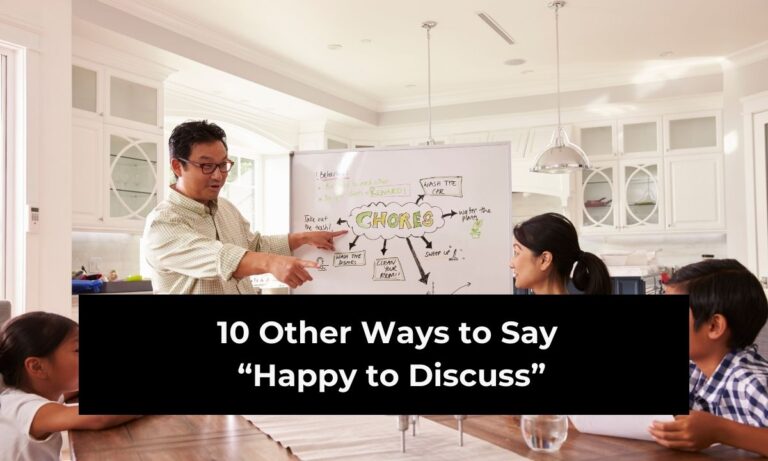When you connect with someone at the end of the day, you often find yourself reaching for the same phrase: “How was your day?” It’s simple, warm, and polite. But after a while, it can start to feel repetitive, especially if you’re trying to keep conversations fresh and meaningful. Whether you’re texting a partner, talking to a friend, or checking in with a coworker, repeating the same line may not capture the deeper curiosity or care you want to express.
Think about it: when someone asks you “How was your day?”, you probably respond with a short, automatic answer—something like “It was fine” or “Pretty good.” While that’s perfectly acceptable, it often doesn’t spark deeper conversations or show that you’re truly interested in the details of their experience.

That’s why finding other ways to say “How was your day” can make such a difference. By choosing fresh, thoughtful alternatives, you show genuine care and invite the other person to share more openly. It helps you break away from routine conversations and strengthen your relationships, whether personal or professional.

The good news is that you don’t need to be a poet or a master conversationalist to find better ways to ask. Simple tweaks, rephrased questions, and creative wording can instantly make your conversations feel warmer and more engaging.
In this article, you’ll discover 10 unique alternatives to “How was your day”, each explained with examples, contexts, and tips. These aren’t just phrases—they’re doorways to deeper, more heartfelt conversations. By the end, you’ll have a toolkit of expressions you can use to keep your check-ins thoughtful, varied, and genuinely meaningful.
1. “What was the best part of your day?”
This phrase takes the spotlight off the generic “how was it” and directs it toward something positive. Instead of asking for an overall summary, you’re inviting the other person to focus on a highlight, no matter how small.
When you ask someone this, it encourages them to reflect on moments that made them smile or feel accomplished. Maybe they enjoyed their morning coffee, had a meaningful conversation, or completed an important task. Whatever it is, this version of the question makes space for gratitude and positivity.
It’s especially powerful if you’re talking to someone you care deeply about, like a partner or close friend. It shows you’re genuinely curious about what brightened their day, even if it was a stressful one overall. For example, if they say, “I finally finished that report I was stressed about,” you have the chance to celebrate with them instead of just nodding at a generic “It was okay.”
This phrasing also works well in group settings or even at the dinner table. Asking your kids or family members what their favorite part of the day was can spark joy and connection, creating meaningful daily rituals.
By focusing on the highlight, you’re not only keeping the conversation light and uplifting but also giving the other person permission to relive a happy moment, which deepens your bond.
2. “Did anything interesting happen today?”
This alternative opens the door to stories and details that a typical “How was your day” might not uncover. It’s broader and leaves room for surprises.
The word “interesting” makes people think about their day differently. Instead of offering a one-word reply, they’re prompted to recall something unique. It might be a funny encounter, an unexpected challenge, or even a new discovery. This way, you’re encouraging storytelling instead of short answers.
For example, if a coworker responds, “Yes, I tried a new café near the office,” you now have an entry point into a conversation about food, routines, or even favorite spots. Similarly, if your partner says, “Actually, something funny happened at work,” you’ve created space for laughter and connection.
This question works best in casual settings where you want to spark engaging conversations. It’s great for check-ins over dinner, phone calls, or even messages. The beauty of this phrase is that it feels natural and curious without being too formal.
By shifting the focus from “good” or “bad” to “interesting,” you’re signaling that you want details—not just surface-level updates. It makes your curiosity clear and helps avoid repetitive, routine answers.
3. “What did you spend most of your time on today?”
This version encourages someone to walk you through the flow of their day without feeling pressured to summarize it as “good” or “bad.” It gently asks for details while leaving the conversation open.
When you ask this, you’re showing interest in the person’s activities, not just the overall impression of the day. They might respond with, “I spent most of the day in meetings,” or “I worked on that project we talked about.” From there, you can dive deeper: “How did the meetings go?” or “Was the project stressful?”
This is especially useful in professional settings where you want to connect without sounding too personal. For example, asking a colleague, “What did you spend most of your time on today?” gives them the chance to share priorities or challenges without straying into overly private territory.
In personal relationships, it works just as well. If your partner says, “I spent most of my time studying for exams,” it gives you insight into their stress levels, focus, and daily experiences.
What makes this question valuable is that it shows you care about the details. It’s less about judgment and more about curiosity. You’re essentially saying, “Walk me through what mattered most today.”
4. “How are you feeling about today?”
Sometimes the focus shouldn’t just be on what happened but on how someone feels about it. Asking “How are you feeling about today?” goes deeper than a surface-level check-in.
This phrase shifts the conversation to emotions. Instead of listing tasks or events, the person is invited to reflect on their mood and mindset. For instance, someone might say, “I feel relieved because I finished something big,” or “Honestly, I feel drained from all the calls.”
This approach is particularly valuable in close relationships. It lets people know you care not just about what they did but about how they experienced it. It’s a way of validating emotions and showing empathy.
It also works well for children or teens who might not always volunteer their feelings. Asking them directly how they felt about their day makes it easier to share emotions that might otherwise stay hidden.
By using this phrase, you shift the check-in from a simple update to a moment of connection. It encourages vulnerability and honesty, which can deepen trust. Whether in friendships, family conversations, or romantic relationships, it helps you get closer to the person behind the events.
5. “What’s something new you learned today?”
This alternative adds a sense of curiosity and growth to your conversations. By asking about learning, you’re encouraging reflection and self-discovery.
The answer doesn’t have to be something academic or groundbreaking. It could be as simple as, “I learned a new recipe,” or “I figured out how to fix my phone issue.” Even small learnings become conversation starters.
This phrase works particularly well with kids or students. It gets them thinking about their day in terms of discovery rather than just routine. It can also help reinforce a positive mindset of continuous growth.
In personal relationships, asking this can show that you care about your partner’s experiences and want to celebrate their small wins. At work, it can serve as a light way to reflect on challenges and lessons.
The beauty of this question is that it shifts the focus from the past (“How was it?”) to something forward-looking. You’re helping the other person reflect on progress, which can boost confidence and positivity.
It’s not just a check-in—it’s an invitation to share insights, discoveries, and even mistakes in a way that feels engaging and meaningful.
6. “How did today compare to yesterday?”
This question adds perspective. Instead of treating the day in isolation, you’re asking the person to reflect on differences or similarities with the day before.
It encourages them to think more deeply about patterns in their life. Maybe they’ll say, “Today was less stressful than yesterday,” or “Actually, it was pretty much the same.” Either way, it provides a bigger picture of how they’re doing overall.
This question works well in both personal and professional settings. In personal conversations, it can help you notice changes in someone’s mood or energy. For example, if a friend mentions they’ve been feeling better today, it gives you a chance to celebrate with them. If they say it was worse, you can offer support.
In work settings, it can spark discussions about productivity and energy levels. A colleague might reflect on what helped them manage stress differently or what challenges carried over.
Asking someone to compare days shows that you’re paying attention not just to isolated moments but to patterns in their life. It demonstrates a deeper level of care and curiosity.
7. “What’s one thing that made you smile today?”
This is a lighthearted, uplifting way to check in. By focusing on a smile-worthy moment, you encourage the other person to recall something positive.
It could be a funny conversation, a kind gesture, or even something simple like seeing a pet do something silly. These small moments often go unnoticed, but when highlighted, they create warmth and connection.
This question is perfect for winding down at the end of the day. It’s especially great with children, as it trains them to reflect on the bright spots in their day. For partners, it can become a sweet ritual that reinforces positivity in the relationship.
Even in professional environments, this phrase works well to add a touch of humanity. Asking a coworker what made them smile can lighten the mood and strengthen workplace bonds.
The power of this question lies in its simplicity. Smiles are universal, and asking about them makes conversations instantly more joyful.
8. “What’s something you’re looking forward to tomorrow?”
This alternative flips the focus forward instead of backward. Instead of only reflecting on the day that has passed, you’re sparking anticipation and excitement for what’s ahead.
When you ask this, you’re helping the other person shift their mindset toward the future. It could be something small like enjoying a favorite meal, or something bigger like an important meeting or event. Either way, it creates a sense of momentum and positivity.
In relationships, this question helps you learn more about the other person’s hopes, plans, and priorities. It gives you an opportunity to support them, encourage them, or even join them in whatever they’re excited about.
With kids, it’s an excellent way to build anticipation and teach them to look forward to positive things. In workplaces, it can spark motivation and focus.
By asking this, you’re showing not only that you care about their current state but also about what’s ahead. It creates an ongoing thread in conversations, connecting today to tomorrow in a meaningful way.
9. “If you could change one thing about today, what would it be?”
This version takes a more reflective approach. It invites someone to share not just what happened but how they might improve or adjust it.
It’s an especially good question if you sense that someone had a tough day but isn’t opening up. By framing it as a hypothetical, it gives them the freedom to share frustrations or challenges without feeling like they’re complaining.
For instance, they might say, “I wish I didn’t have to sit in traffic so long,” or “I would have handled that meeting differently.” These insights give you a chance to empathize, support, or simply listen.
In personal relationships, it shows that you care about their struggles as much as their successes. At work, it can open the door to problem-solving discussions about productivity or stress.
This phrasing is powerful because it acknowledges imperfection. Not every day is great, and this question validates that reality while still keeping the tone constructive.
10. “What’s one word you’d use to describe your day?”
Sometimes the simplest questions create the most thoughtful answers. Asking for just one word forces the other person to pause, reflect, and choose carefully.
They might say “busy,” “exciting,” “overwhelming,” or “peaceful.” Whatever the response, it gives you an immediate glimpse into how they experienced the day. From there, you can follow up with curiosity: “What made it feel exciting?” or “Why did it feel overwhelming?”
This question works beautifully with both adults and kids. For children, it’s a fun, game-like way to summarize their day. For adults, it’s a meaningful shortcut to understanding how they really feel.
It’s also a powerful conversation starter in group settings. Each person can choose a word, and together you get a colorful snapshot of everyone’s day.
By simplifying the question to one word, you’re creating space for honesty and creativity. It’s a refreshing twist that avoids routine and deepens connections.
Conclusion
At first glance, “How was your day?” seems like the perfect conversation starter. But when you ask it every day, the answers can quickly become automatic and shallow. By using alternatives, you can transform routine check-ins into genuine, heartfelt moments of connection.
Each of the 10 alternatives we’ve covered gives you a unique way to show curiosity, care, and presence. Whether you’re focusing on highlights, emotions, learning, or anticipation, these phrases open doors to deeper conversations and stronger relationships.
The real secret isn’t just the words you choose—it’s the intention behind them. When you ask with genuine interest, people feel valued, seen, and understood. And when conversations move beyond the surface, bonds naturally grow stronger.
So the next time you’re tempted to ask the usual “How was your day,” try one of these alternatives instead. You’ll not only make your conversations more engaging but also create moments of joy, reflection, and connection that matter far more than small talk.
FAQs
1. Why should I stop saying “How was your day?”
Because it often leads to short, automatic answers. Alternatives encourage deeper, more meaningful conversations.
2. Are these alternatives better for personal or professional settings?
They work in both. Some, like “What did you spend most of your time on today?” are great at work, while others, like “What’s one thing that made you smile?” shine in personal conversations.
3. How can I make these questions feel natural?
Use them sparingly and adapt based on the context. The key is sounding curious and genuine, not scripted.
4. Can I use these alternatives with kids?
Yes. Questions like “What’s something new you learned today?” or “What made you smile?” are especially great for children.
5. What if someone doesn’t want to share details?
Respect their space. You can keep it light or follow up with something supportive like, “I’m here if you want to talk about it.”





